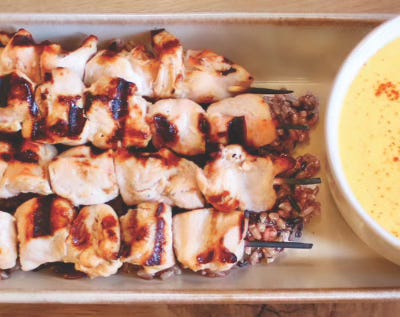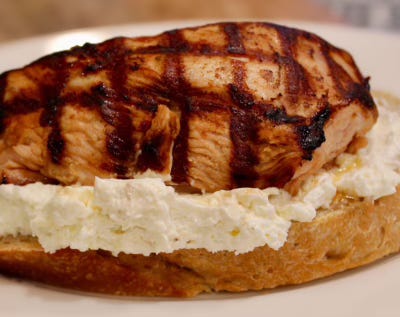There are so many uses for grilled chicken breasts, hot and cold, and I love to have them on hand in the summertime. I start by marinating three to four pounds overnight, then I grill the entire batch the following afternoon or evening. Usually, I use about a pound of it to serve immediately, and then chill the rest to add to salads, tacos, pasta, and other dishes. While this post focuses on grilling the chicken, this marinade is also great for sautéed dishes, such as Chicken Piccata.
We tend to eat much healthier with a quick protein in the fridge, and save money by not being tempted to order takeout. For the chicken and marinade in this recipe, I pay approximately $2.66 for a 6-ounce serving (large) and $1.77 for a 4-ounce serving (standard). Compare that to an add-on of grilled chicken to a salad, which can cost $8 for about 3 ounces in a restaurant. Scroll to the bottom to view the recipe’s cost breakdown. Prices will vary, but for reference, I shopped at Costco in Bend, Oregon.
This simple marinade was the secret behind the success of several menu items at my family’s restaurant, The Treehouse, and is featured in my cookbook, Living Legacy: Stories of Restaurant Family.
Ingredients: Chicken with Marinade
(8 six-ounce servings, 12 four-ounce servings)
3 pounds boneless, skinless chicken breasts
1/2 large yellow or white onion
1/2 teaspoon salt
1/2 teaspoon white pepper
1 cup lemon juice, freshly squeezed or bottled pure lemon juice
2 tablespoons olive oil
*non-stick cooking spray (for grilling)
Cut the chicken breasts in half or thirds (depending on their size) on the diagonal into 4- to 6-ounce filets. (It’s not necessary to weigh the chicken; you can eyeball the approximate serving size you want.)
Pound the chicken to a uniform thickness, which helps them cook more evenly and faster. Line a cutting board with plastic wrap to place the chicken on, then place another sheet of plastic wrap on top of the chicken before pounding it with a meat tenderizing mallet. Be sure and leave enough room for the chicken to spread. I usually do two or three filets at a time. Be patient with your pounding. Sometimes it takes several times for the chicken to yield to flattening.
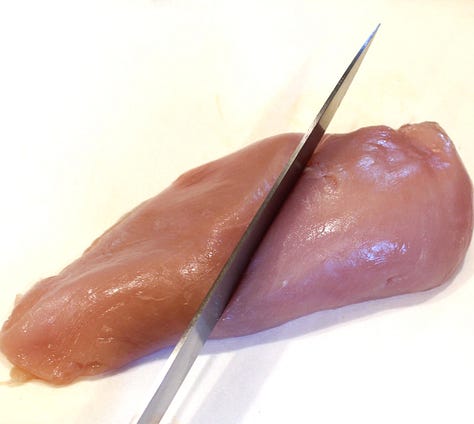


If you don’t have a meat tenderizing mallet, a large, heavy flat spoon or a small sauté pan can do the trick. I recommend having one, though, if you cook a lot of chicken. They are about $15, and you can find them at most large grocery stores.
Once your chicken is prepped, place it in a large bowl that can be covered tightly or a couple of large zip-lock bags. Slice/chop the onion and juice the lemons, and add them to the chicken along with salt, white pepper, and olive oil. Stir to combine.
Cover the bowl or seal the bags and allow the chicken to marinate in the refrigerator for at least 8 hours and up to 48 hours. Do not worry if the chicken turns white; this is a harmless reaction caused by the lemon juice.
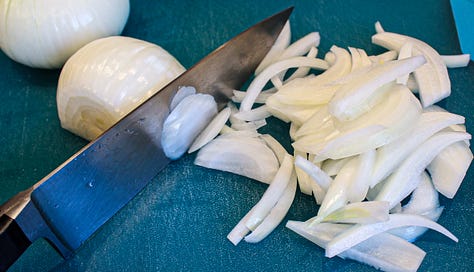
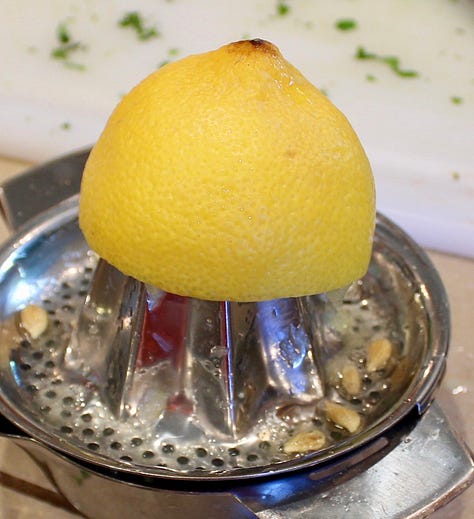
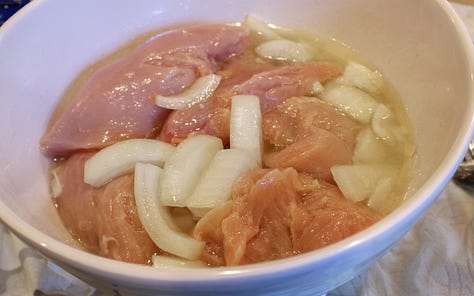
Grilling
Preheat a gas grill on high heat with the cover on until it reaches 500º F
Remove the chicken breasts from the marinade, shaking off excess, and place them on a large flat surface (like a platter ot cutting board). Blot them with paper towels to remove more of the marinade and prevent it from dripping on the grill.
Lift the cover of the preheated grill and make sure it’s clean; use a grill brush as needed.
*Ideally, meat releases when it is ready to turn, but I’ve found chicken breasts often need a little help with that. If you feel you need to use some non-stick cooking spray, turn the burners off so there is no flame when you coat the grill, then immediately turn them back on to medium-high heat. Alternatively, you can spray the chicken directly with non-stick spray before placing it on the grill over medium-high heat. Some people may say the spray ruins the grill, but I’ve never noticed any harm, and it makes life much easier when the chicken doesn’t stick.
Turn the heat down to medium-high and carefully place the chicken on the grill, leaving a couple of inches between each breast. Cover the grill and allow 3 - 4 minutes for grill marks to form. Then, rotate the chicken breasts 90 degrees without turning them over to achieve the classic criss-cross grill marks. Allow them to cook, covered, for 3-4 more minutes before turning them over and cooking for an additional 6 -8 minutes, depending on their thickness. An instant meat thermometer should register 165º F for safe consumption.
Serve the chicken hot, or allow it to cool and refrigerate it for use in summer salads, sandwiches, and other dishes. Pictured below are two classics from the cookbook. Both were listed as Poulet Grille on the menus, but the chicken was served kabob-style with hollandaise sauce for dinner, and for lunch, it was served on toasted sourdough with cream cheese. So simple and delicious.
I’d love to hear your favorite way to serve grilled chicken, and let me know if you’ve tried this recipe!
Organic Chicken Breast - 19.20, Onion - .30 - Lemon Juice (from 4 - 5 fresh lemons) 1.50, Organic Olive Oil - .28
Total: 21.28







